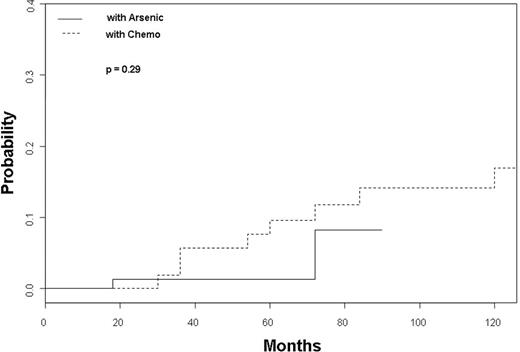Abstract
Abstract 1085
Progress in the treatment of patients (pts) with acute promyelocytic leukemia (APL) with the use of modern all-trans retinoic acid (ATRA)-containing regimens has resulted in the majority of pts achieving long-term disease-free survival. There is little data on the incidence and patterns of secondary neoplasms in pts treated with these regimens.
To compare the incidence of secondary neoplasms in pts with APL treated with two different ATRA-containing regimens.
We retrospectively examined the charts of 160 pts with APL treated with ATRA plus chemotherapy (n=54) or ATRA plus arsenic trioxide (ATO)(n=106) as their initial induction regimen at the University of Texas – M. D. Anderson Cancer Center from 1991 to 2009. Twenty seven (17%) pts had a remote history of a prior unrelated cancer. Pt characteristics and the incidence of secondary cancers per unit time of follow-up were compared.
The median age at diagnosis of the entire population was 44 years (range, 13 – 81) and the median age for the chemotherapy plus ATRA group was 38 years (range, 13–67) vs. 46 years (range, 14 – 81) for the pts treated with ATO plus ATRA (p= 0.001). Thirty (55%) and 54 (50.9%) in each cohort were women (p=0.52) and 2 (3.7%) and 26 (24.5%) were older than 60 years of age, respectively (p= 0.001). Twenty (37%) and 30 (28.3%) had high risk disease (WBC > 10 × 109/l)(p= 0.3), and 34 (62.9%) and 76 (71.6%) had low risk disease (WBC ≤ 10 × 109/l), respectively. Fifty one (94.4%) and 105 (99%) pts treated using the two regimens achieved a CR. The median follow-up time for the two cohorts was 136 and 29 months [ranges, (5 to 193) and (1 to 93), respectively]. Nine and 2 pts in the two groups developed secondary cancers including 2 breast cancers, 3 MDS/AML, 1 vulvar cancer, 1 prostate cancer, 1 colon cancer and 1 soft tissue sarcoma in the chemotherapy group vs. 1 melanoma and 1 pancreatic cancer in ATO group. The cumulative incidence of secondary cancers in the two cohorts is shown in figure 1.
Treatment of pts with APL using the non-chemotherapy regimen of ATRA plus ATO is not associated with a higher incidence of secondary cancers (p=0.29) adjusted for unit time exposure.
Off Label Use: Use of arsenic trioxide in frontline therapy of APL. Ravandi:Cephalon: Honoraria, Research Funding, Speakers Bureau.
Author notes
Asterisk with author names denotes non-ASH members.


This feature is available to Subscribers Only
Sign In or Create an Account Close Modal